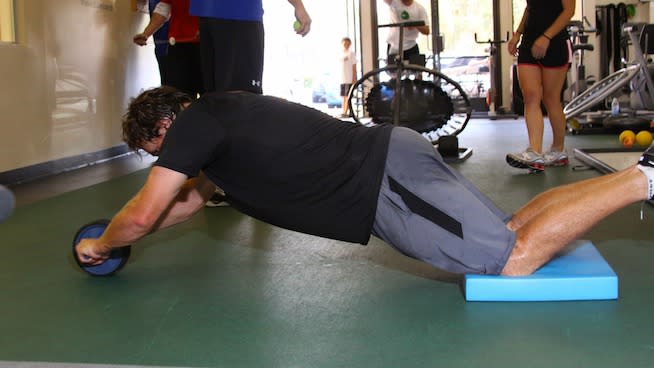Train Your Core Like a Pro Without Getting Hurt

The Hanging Knee Raise and Wheel Roll-Out are two staple core exercises commonly used by pro athletes to build dynamic stability and strength in their abs. By no coincidence, these same exercises could seriously harm the average guy who just watched a UFC special and thinks they are perfect for him.
Professional athletes make difficult exercises look easy. People watch athletes perform these exercises on YouTube and think, "how hard can that be?" Therein lies the problem. Without a proper base of core stabilization for these exercises, you can suffer an injury in the form of joint problems, spinal pathology, shoulder trauma or abdominal hernias.
RELATED: UNC Baseball Hanging Knee Raise
Here are two unique ways to train these beneficial patterns without ending up in the physiotherapist's office.
The End is Near
Adding an end point to your Wheel Roll-Out allows you to progress the exercise without losing control and going too far. Brace your core with a wall before you roll out. Bracing your core should feel the same as flexing your biceps—hard enough to feel your triceps at the same time. Your abs are the biceps and your low back is the triceps in this analogy.
Start close to the wall.
Each set, move your knees 3 inches back from the previous set.
If you find a position where you cannot brace your core throughout the entire range of motion, go back to the easier position and work from there.
Lock and Load
When the Hanging Knee Raise is used to target the rectus abdominus, a posterior pelvic tilt shortens the muscle and leads to focused development. This motion is good for those with a postural low back curve that looks like a Tsunami wave, or martial artists and soccer players who want to improve their front kicking mechanics.
RELATED: The 18 Best Core Exercises for Athletes
First, complete a progression using easier floor exercises. The hardest transition is from the Floor Leg Raise to the Hanging Knee Raise, and this tweak is an important technique to keep your back safe and bridge the gap between the two movements. To start, use slings instead of a straight arm hang to allow for more activation of the lats, which can offer greater stabilization of the lumbar spine.
Set a bench perpendicular to you. Place it far enough in front so you can rest your feet on it with your knees locked out.
Drop your shoulders by digging your elbows into the slings.
With your legs straight, tilt your pelvis posteriorly by tucking it under and squeezing your glutes tight.
Brace your core, keep your glutes squeezed and raise your legs to your elbows by bending them and curling your spine.
Pause at the top for two seconds and return to the start position under control.
If you can't maintain glute and core contraction, back to less advanced work until you can.
References:
Mayo Clinic Staff. "InguinalHernia." <http://www.mayoclinic.org/diseases-conditions/inguinal-hernia/basics/causes/con-20021456>.March 20, 2013. Web. Seen May 19, 2014.
McGill, Stuart. "Low Back Disorders: Evidence Based Prevention and Rehabilitation." Human Kinetics, 2002. ISBN:0-7360-4241-5. Printed in USA.
Purcell,Laura, MD and Micheli, Lyle MD. "Low Back Pain in Young Athletes." Sports Health. May 2009; 1(3): 212–222.doi:10.1177/1941738109334212. London Health Sciences Centre, London,Ontario, Canada. Boston Children's Hospital, Boston, Massachusetts.
Yoo WG."Effect of the Individual Strengthening Exercises for Posterior Pelvic Tilt Muscles on Back Pain, Pelvic Angle, and Lumbar ROM of a LBP Patient with Excessive Lordosis: A Case Study." J Phys Ther Sci. 2014Feb;26(2):319-20. doi: 10.1589/jpts.26.319. Epub 2014 Feb 28.
This article originally appeared on STACK.com: Train Your Core Like a Pro Without Getting Hurt

